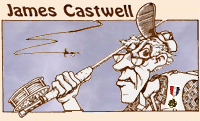|
It had been a fun summer day. Neil and I had fished
the hatch and spinner-fall and I suppose we had caught
a few fish but I really don't remember if we did or not.
I had a twenty-foot Holiday trailer which I parked on
the weekends by the great Mainstream of Michigan's
famous blue-ribbon Au Sable river. In those days of
the early seventies it was catch and keep, not fish
but insects. Not much was in print then about insects,
some, but limited, and identification of the exact
specie was only possible with technical papers published
by universities and state departments, notably Illinois
being one and Michigan the other. Both had done well on
publishing but they were not intended for fly fishers.
We had to dig them out and that was fun too. We had the
books and devoured them on every occasion.
This particular evening we sat opposite each other in
the dining area of my trailer pouring over the duns,
spinners and nymphs we had collected during our day
astream. I still have the books we used that evening
here as I write this. Memories on a shelf just waiting
to be re-run anytime I like. I don't do that often, but
they are old friends I see each day, important friends
at that. They are some of the books that helped me learn
about what trout eat. Learning the habits of the trout's
food made presenting my tied copies not only more
interesting but when you can know even more about what
you are doing it makes it all the better.
Not that simply flinging a dry fly to a ripple isn't fun,
hell yes it is. Been there, done that, more than once. But,
knowing the name of the insect, its various stages and
how it looks during it's molts makes creating a fly for
those stages not only easier but far more interesting. I
am not going to give you the names of the publications I
have, most likely been out of print for half a century by
now, but, they did the job and I still have mine.
You see, I didn't have the Internet back then, it was
books or nothing. I remember having a library card a
long time ago. What an experience, my hat is off to
those of you who can handle that game. I tried not to
take out books that I didn't want and any I did take
out I wanted to keep. The temptation often became severe.
Once I had an autographed copy of a book by Charlie Fox,
yup, from the library. The thought of offering to pay for
the book because "I had lost it" did enter my mind. And
no, I didn't keep it. In fact I felt grateful to whomever
had donated it in the first place. Thank you someone, you
helped get me hooked.
Neil and I spent at least a couple of hours that evening
by the hissing white light of the Coleman lantern. Books,
magnifying glasses, loops, tweezers and two cups of coffee.
Little bottles, isopropyl alcohol, small plastic boxes,
comradeship and memories; all fine collectibles that evening.
It would not have occurred with a computer there, it had to
be books to set the stage for the evenings learning and
advancing our quest for more and more information about
trout and their food and habits.
So here I am, with a rather big web-site trying to sell
ou on the idea of spending some of your hard earned bucks
on books instead of rods and reels. Remember, one power-out
and I am history. Not so with a book and a candle. One good
'virus' and I'm off the air. This stuff really does not even
exist, we are just a collection of pluses and minuses.
Electric bits of flotsam at best.
But, be very careful of what you buy for books. Many are
simply re-hashes of something either the author has written
earlier of swiped from another author from an earlier time
and re-named. Many books are written as a monument to the
author by himself, avoid these. Look for those which actually
include real information not opinion. Books on knots are fun
but, really most of us only use a few knots that become
favorites and although others may be dandy, we don't bother
to even learn them. Those on casting are all over the place,
but once you learn to cast then what? Patterns of flies are
nice to have but, do you really have the insects in your
region that they are representing? And remember those methods
are simply how that writer does it, nothing is cast in stone
in fly tying either.
Make it another part of your fly-fishing life, further
your state-of-mind in the field of our sport and make
more use of your fishing dollars. I mean, just how many
rods do you really need anyhow?
~ James Castwell
|



